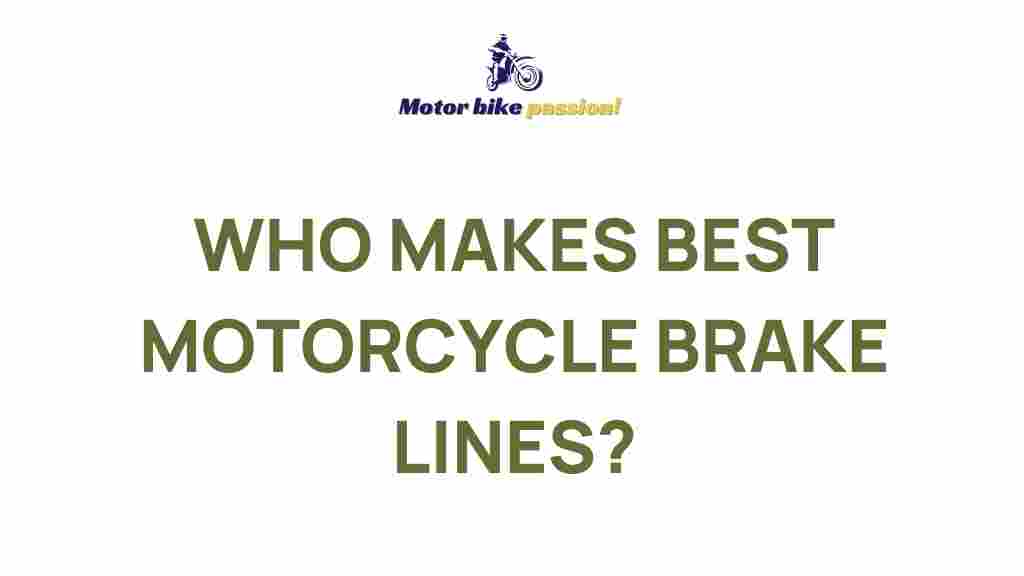Welcome to your ultimate guide on motorcycle brake lines!
Unveiling the Top Motorcycle Brake Lines
Upgrading your motorcycle brake lines is an essential step to ensure optimal safety and performance. High-quality brake lines provide superior stopping power, reduce brake fade, and enhance responsiveness. In this guide, we delve into expert reviews and recommendations to help you find the best options for your bike.
Why Are Brake Lines Important for Your Motorcycle?
Your motorcycle’s braking system is crucial for safety, and the brake lines play a vital role in transferring hydraulic pressure from the brake lever to the calipers. Over time, stock rubber brake lines can degrade, leading to reduced performance. Upgrading to braided stainless steel or Teflon brake lines can provide significant advantages:
- Durability: Braided lines resist wear and tear, ensuring a longer lifespan.
- Improved Braking: Enhanced pressure consistency for precise stopping power.
- Aesthetic Appeal: Available in various colors to match your motorcycle.
Top Motorcycle Brake Lines: Expert Recommendations
Here are our top picks for the best motorcycle brake lines available:
- Galfer Steel Braided Brake Lines: Known for their robust construction and excellent performance, these lines reduce brake fade significantly. Learn more about Galfer products.
- HEL Performance Brake Lines: Trusted by professional racers, HEL brake lines offer exceptional reliability and customizability.
- Earl’s Performance Lines: These lines are perfect for riders seeking high-quality materials and compatibility with various motorcycle models.
How to Install Motorcycle Brake Lines
Installing new brake lines on your motorcycle can seem daunting, but with the right tools and a step-by-step approach, it’s manageable. Follow these instructions:
Step 1: Gather Necessary Tools
- New brake lines
- Wrenches (metric and standard)
- Brake fluid
- Rags and cleaning supplies
- Torque wrench
Step 2: Remove Old Brake Lines
Begin by draining the old brake fluid. Use a wrench to carefully loosen and remove the existing brake lines. Keep the area clean to avoid contamination.
Step 3: Install New Brake Lines
Attach the new brake lines to the calipers and master cylinder. Ensure all connections are secure, and use a torque wrench to tighten the fittings to the manufacturer’s specifications.
Step 4: Bleed the Brakes
Fill the brake reservoir with fresh fluid and bleed the brakes to remove any air bubbles. This step is critical for proper brake function.
Step 5: Test Your Brakes
Before hitting the road, test your brakes to ensure they are functioning correctly. Make adjustments if necessary.
Troubleshooting Common Issues
Encountering problems after installing new brake lines? Here are some troubleshooting tips:
- Soft Brake Lever: This often indicates trapped air in the system. Rebleed the brakes thoroughly.
- Fluid Leaks: Inspect all connections for tightness. Replace washers if needed.
- Uneven Braking: Ensure the calipers are properly aligned and not sticking.
If problems persist, consult a professional mechanic or refer to detailed guides on motorcycle maintenance like this comprehensive resource.
Conclusion
Upgrading your motorcycle brake lines is a worthwhile investment in both performance and safety. With options like Galfer, HEL Performance, and Earl’s, you can enhance your riding experience with superior stopping power and reliability. Always follow proper installation steps and address issues promptly to keep your brakes in top condition.
For more motorcycle maintenance tips and product reviews, check out our dedicated guides section. Ride safely and enjoy the open road!
This article is in the category Reviews and created by MotorBikePassion Team
